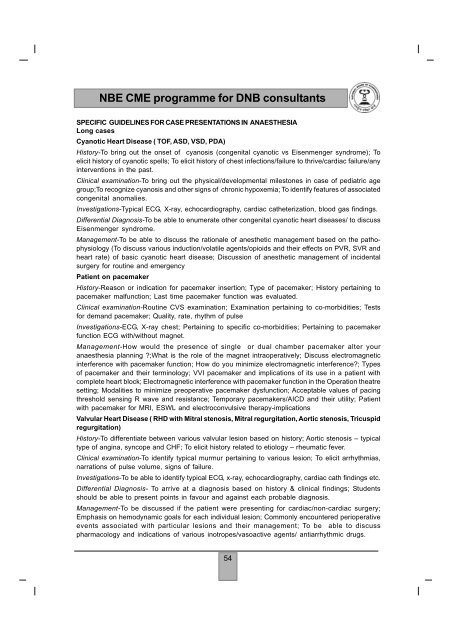<strong>NBE</strong> <strong>CME</strong> <strong>programme</strong> <strong>for</strong> <strong>DNB</strong> <strong>consultants</strong>SPECIFIC GUIDELINES FOR CASE PRESENTATIONS IN ANAESTHESIALong casesCyanotic Heart Disease ( TOF, ASD, VSD, PDA)History-To bring out the onset of cyanosis (congenital cyanotic vs Eisenmenger syndrome); Toelicit history of cyanotic spells; To elicit history of chest infections/failure to thrive/cardiac failure/anyinterventions in the past.Clinical examination-To bring out the physical/developmental milestones in case of pediatric agegroup;To recognize cyanosis and other signs of chronic hypoxemia; To identify features of associatedcongenital anomalies.Investigations-Typical ECG, X-ray, echocardiography, cardiac catheterization, blood gas findings.Differential Diagnosis-To be able to enumerate other congenital cyanotic heart diseases/ to discussEisenmenger syndrome.Management-To be able to discuss the rationale of anesthetic management based on the pathophysiology(To discuss various induction/volatile agents/opioids and their effects on PVR, SVR andheart rate) of basic cyanotic heart disease; Discussion of anesthetic management of incidentalsurgery <strong>for</strong> routine and emergencyPatient on pacemakerHistory-Reason or indication <strong>for</strong> pacemaker insertion; Type of pacemaker; History pertaining topacemaker malfunction; Last time pacemaker function was evaluated.Clinical examination-Routine CVS examination; Examination pertaining to co-morbidities; Tests<strong>for</strong> demand pacemaker; Quality, rate, rhythm of pulseInvestigations-ECG, X-ray chest; Pertaining to specific co-morbidities; Pertaining to pacemakerfunction ECG with/without magnet.Management-How would the presence of single or dual chamber pacemaker alter youranaesthesia planning ?;What is the role of the magnet intraoperatively; Discuss electromagneticinterference with pacemaker function; How do you minimize electromagnetic interference?; Typesof pacemaker and their terminology; VVI pacemaker and implications of its use in a patient withcomplete heart block; Electromagnetic interference with pacemaker function in the Operation theatresetting; Modalities to minimize preoperative pacemaker dysfunction; Acceptable values of pacingthreshold sensing R wave and resistance; Temporary pacemakers/AICD and their utility; Patientwith pacemaker <strong>for</strong> MRI, ESWL and electroconvulsive therapy-implicationsValvular Heart Disease ( RHD with Mitral stenosis, Mitral regurgitation, Aortic stenosis, Tricuspidregurgitation)History-To differentiate between various valvular lesion based on history; Aortic stenosis – typicaltype of angina, syncope and CHF; To elicit history related to etiology – rheumatic fever.Clinical examination-To identify typical murmur pertaining to various lesion; To elicit arrhythmias,narrations of pulse volume, signs of failure.Investigations-To be able to identify typical ECG, x-ray, echocardiography, cardiac cath findings etc.Differential Diagnosis- To arrive at a diagnosis based on history & clinical findings; Studentsshould be able to present points in favour and against each probable diagnosis.Management-To be discussed if the patient were presenting <strong>for</strong> cardiac/non-cardiac surgery;Emphasis on hemodynamic goals <strong>for</strong> each individual lesion; Commonly encountered perioperativeevents associated with particular lesions and their management; To be able to discusspharmacology and indications of various inotropes/vasoactive agents/ antiarrhythmic drugs.54
<strong>NBE</strong> <strong>CME</strong> <strong>programme</strong> <strong>for</strong> <strong>DNB</strong> <strong>consultants</strong>Patient of Scoliosis and kyphoscoliosis <strong>for</strong> anesthesiaHistory-Onset and progress of disease; Associated congenital anomalies; Functional status andneurologic deficits; Previous surgery <strong>for</strong> scoliosis of any; H/O – T.B., Poliomyelitis, Neurofibromatosis,Dysautonomia, Duchenne Muscular Dystrophy ; FAMILY H/O – Malignant Hyperpyrexia as it is morecommon in patients with KYPHOSEOLIOIS.Clinical examination-General physical examination including room air saturation/bedsidepulmonary functiontests; Relevant examination <strong>for</strong> associated syndromes and cardiovasculareffects; Implications of Halo traction; LOOK FOR SIGNS & SYMPTOMS OF- Restrictive Lung Disease,Pulmonary Hypertension, Congenital Heart Disease, Airway Abnormalities, Preexisting NeurologicalDeficitInvestigations-X-ray spine <strong>for</strong> Cobb’s angle and implications; Chest x-ray; Pulmonary functiontests; EchocardiographyManagement-Treatment of underlying infection; Discuss how different surgical approaches –anterior, posterior, transthoracic (open/endoscopic) would alter anaesthetic managements; Chestphysiotherapy and breathing exercises; Implications and techniques of intraoperative neurologicalmonitoring; Intraoperative and postoperative pain management strategies; Minimize blood loss,intraoperative positioning, spinal cord monitoring, Wake up test.Difficult airway (TM Joint ankylosis)History-Course of the restriction and any previous surgery; History of trumaClinical examinations-To be able to per<strong>for</strong>m a detailed airway examination –Mouth opening, neckmovements, patency of nostrils; To elicit associated co-morbiditiesInvestigations-Relevant radiological examination; Investigations pertaining to co-morbiditiesManagement-Special emphasis on consent taking <strong>for</strong> awake intubation/tracheostomy; Modalitiesof securing airway blind nasal, fiberoptic guided etc.; To discuss awake versu asleep modalities ofsecuring the airway; Techniques of airway topicalization; Extubation strategy; Modalities <strong>for</strong> postoperativepain managementHypertensionHistory-History of rise in blood pressure, headache, visual disturbances, nose-bleeding, fatigue,nausea, anxiety, nervousness; History to evaluate end organ damage- CVS, CNS, eyes and renal;History of diabetes, obesity, family history of hypertension,history of exclusion of secondary causesof hypertension- Coarctation of the aorta, Chronic renal disease, Renovascular disease,Glomerulonephritis, Pheochromocytoma, Primary adosteronism, Cushing’s syndrome, Intracraniallesions, Estrogens/oral contraceptives, steroidal & NSAIDS, nasal decongestants, appetitesuppressants, and the tricyclic antidepressants, Excessive alcohol intake; Treatment history.Clinical signs- Accurate measurement of blood pressure with proper size cuff over a week; Palpationof all peripheral pulses should be per<strong>for</strong>med; Look <strong>for</strong> renal artery bruit over the upper abdomen;the presence of a unilateral bruit with both a systolic and diastolic component suggests renal arteryStenosis; Examination of neck <strong>for</strong> thyroid enlargement, bruits, distended veins; Examination of thelungs; Examination of the heart <strong>for</strong> increased rate, size, precordial heaves, rhythm, gallops, murmurs;Examination of abdomen <strong>for</strong> enlarged kidneys, masses, aortic dilatation, bruits; Examination ofextremities <strong>for</strong> edema; Neurological assessment; Careful cardiac examination to evaluate signs ofLVH; Displacement of apex; A sustained and enlarged apical impulse presence of an S 4;TambourS 2occasionally (with aortic root dilatation)Differential diagnosis-Adrenal Adenoma, Aortic Coarctation, Aortic Dissection, Apnea, Sleep,Atherosclerosis, Atherosclerotic Disease of the Carotid Artery, Cardiomyopathy, Cocaine,Cardiomyopathy, Hypertrophic Hyperaldosteronism, PrimaryHypertension, Hypertension andPregnancy, Hypertension, Malignant Hypertensive Heart Disease, Hyperthyroidism, ObstructiveSleep Apnea – Hypopnea Syndrome, Pheochromocytoma, Renal Artery Stenosis.55
















